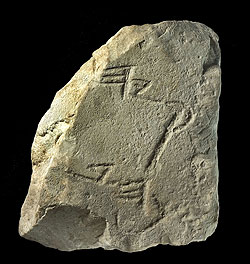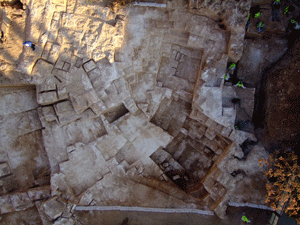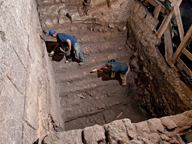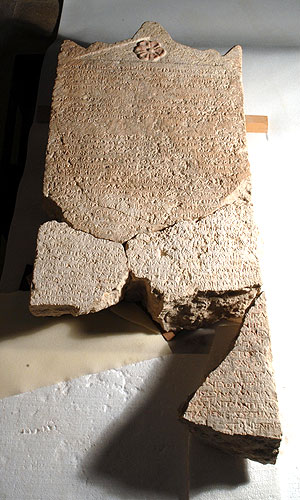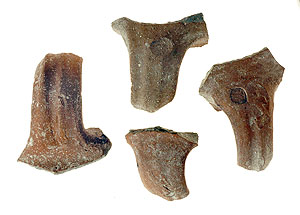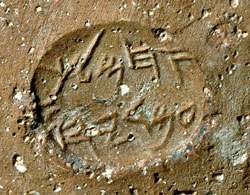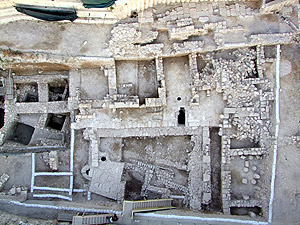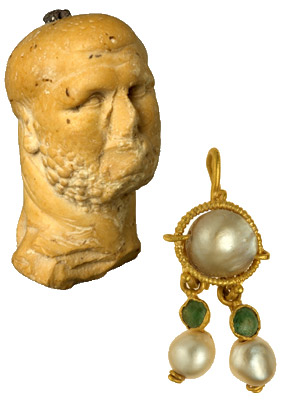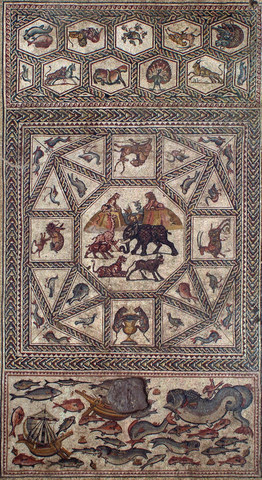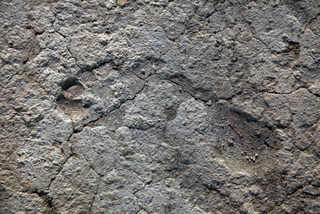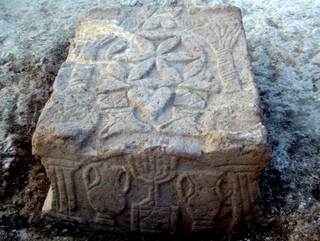Ethiopian desert yields fossils that paint new picture of human evolution
Nearly 17 years after plucking the fossilized tooth of a new human ancestor from a pebbly desert in Ethiopia, an international team of scientists today (Thursday, Oct. 1) announced their reconstruction of a partial skeleton of the hominid, Ardipithecus ramidus, which they say revolutionizes our understanding of the earliest phase of human evolution.
The female skeleton, nicknamed Ardi, is 4.4 million years old, 1.2 million years older than the skeleton of Lucy, or Australopithecus afarensis, the most famous and, until now, the earliest hominid skeleton ever found. Hominids are all fossil species closer to modern humans than to chimps and bonobos, which are our closest living relatives.
"This is the oldest hominid skeleton on Earth," said Tim White, University of California, Berkeley, professor of integrative biology and one of the co-directors of the Middle Awash Project, a team of 70 scientists that reconstructed the skeleton and other fossils found with it. "This is the most detailed snapshot we have of one of the earliest hominids and of what Africa was like 4.4 million years ago."
White and the team will publish the results of their analysis in 11 papers in the Oct. 2 issue of the journal Science, which has Ardi on the cover. They announced their findings at press conferences held simultaneously today in Washington, D.C., and Addis Ababa, Ethiopia.
The team's reconstruction of the 4-foot-tall skeleton and of Ardi's environment – a woodland replete with parrots, monkeys, bears, rhinos, elephants and antelope – alters the picture scientists have had of the first hominid to arise after the hominid line that would eventually lead to humans split about 6 million years ago from the line that led to living chimpanzees.
Based on a thorough analysis of the creature's foot, leg and pelvis bones, for example, the scientists concluded that Ardi was bipedal – she walked on two legs – despite being flat-footed and likely unable to walk or run for long distances.
In part, this primitive ability to walk upright is because Ardi was still a tree-dweller, they said. She had an opposable big toe, like chimpanzees, but was probably not as agile in the trees as a chimp. Unlike chimps, however, she could have carried things while walking upright on the ground, and would have been able to manipulate objects better than a chimp. And, contrary to what many scientists have thought, Ardi did not walk on her knuckles, White said.
"Ardi was not a chimpanzee, but she wasn't human," stressed White, who directs UC Berkeley's Human Evolution Research Center. "When climbing on all fours, she did not walk on her knuckles, like a chimp or gorilla, but on her palms. No ape today walks on its palms."
Ardi's successor, Lucy, was much better adapted for walking on the ground, suggesting that "hominids became fundamentally terrestrial only at the Australopithecus stage of evolution," he said.
Based on Ardi's small, blunt, upper canine teeth, the team also argues that the males of that species did not engage in the same fearsome, teeth-baring threat behavior common in chimpanzees, gorillas and orangutans. Instead, they must have had a more amicable relationship, the scientists said, implying that several pair-bonded couples lived together in social units. Males may even have helped in gathering food for sharing.
"The novel anatomy that we describe in these papers fundamentally alters our understanding of human origins and early evolution," said anatomist and evolutionary biologist C. Owen Lovejoy of Kent State University, a scientist with the project. In a summary article in Science, Lovejoy wrote that these and other behaviors "would have substantially intensified male parental investment – a breakthrough adaptation with anatomical, behavioral, and physiological consequences for early hominids and for all of their descendants, including ourselves."
Until now, the oldest fossil skeleton of a human ancestor was the 3.2-million-year-old partial skeleton of Lucy, discovered in the Afar depression of Ethiopia, near Hadar, in 1974 and named Au. afarensis.
In 1992, however, while surveying a site elsewhere in the Afar, near the village of Aramis, 140 miles northeast of Addis Ababa, Middle Awash Project scientist Gen Suwa discovered a tooth from a more primitive creature more than 1 million years older than Lucy. After more fossils of the creature were found in the area from some 17 individuals, Suwa, White and project co-leader Berhane Asfaw published the discovery in the journal Nature in 1994.
Although that first paper initially conservatively placed the chimp-like creature in the Australopithecus genus with Lucy, the team subsequently created a new genus – Ardipithecus – for the hominid because of the fossils' significantly more primitive features.
After preparing their first report, the scientists continued to find more Ar. ramidus fossils in the Aramis area. A hand-bone discovered in 1994 by project scientist Yohannes Haile-Selassie, a paleontologist and curator at the Cleveland Museum of Natural History, eventually led the team to the partial skeleton now known as Ardi, which they excavated during three subsequent field seasons. The skeleton was disarticulated and scattered, and broken into smaller pieces: 125 fragments of skulls, teeth, arms, hands, the pelvis, legs and feet. In addition to this skeleton, the area yielded a total of 110 other catalogued specimens representing body parts of at least 36 other Ardipithecus individuals.
After the bones were excavated at the site, they were molded and painstakingly removed from their protective plaster jackets in the laboratory in Addis Ababa, where they were then photographed and reconstructed. Micro-CT scanners were used to study the inner and outer anatomy of the bones and teeth, and scanning electron microscopes were used to study the structure and surface details. The 5,000 micro-CT slices through the broken skull allowed the team to reconstruct it on a computer and then "print" it on a 3-D stereolithic printer at the University of Tokyo. A cast of Ardi's skull, along with video and comparisons, can be seen now in the Human Evolution display on the second floor of UC Berkeley's Valley Life Sciences Building.
In all, 47 scientists from 10 countries contributed to the 11 Science papers, providing detailed analyses of the feet, pelvis, teeth and general anatomy of Ar. ramidus and reconstructions of the geology and biology of the area where Ardi lived 4.4 million years ago. Two of the papers analyze more than 150,000 plant and animal fossils – including 6,000 individually catalogued vertebrate fossils – to reconstruct the large and small mammals and birds of the area. Among these are 20 species new to science, including shrews, bats, rodents, hares and carnivores.
"We had to do a lot of work to bring this world back to life, but by merging the skeletal information with the data on biology and geology, we end up with a very, very high-resolution snapshot of Ardi's world," White said. "It was a very cold case investigation."
CTs of the tooth enamel, for example, revealed that Ardi was an omnivore, eating a diet different from that of living African apes, such as chimps, which eat primarily fruit, and gorillas, which eat primarily leaves, stems and bark. The team suggests that Ardipithecus spent a lot of time on the ground looking for nutritious plants, mushrooms, invertebrates and perhaps small vertebrates.
It wasn't until 1 million years after Ardi that hominids like Lucy were able to range extensively into the savannas and develop the robust premolar and molar teeth with thick enamel needed to eat hard seeds and roots. One of these species then started scavenging and using stone tools to butcher larger mammals for meat, "paving the way to the evolution and geographic expansion of Homo, including later elaboration of technology and expansion of the brain," White said.
White said Ardi, who probably weighed about 110 pounds, had a brain close to the size of today's chimpanzees – one-fifth that of Homo sapiens – and a small face. Males and females were about the same size. The hominid's lack of resemblance to either chimp or modern humans indicates that the last common ancestor of apes and humans looked like neither, he said, and that both lines have evolved significantly since they split 6 million years ago.
White admits that the relationship between Ar. ramidus and the Australopithecus fossils the team has found about 80 meters higher in the strata of the Ethiopian desert is tentative. Nevertheless, he said Ardi's species could be the direct ancestor of Lucy's species, which could be the direct ancestor of modern humans. Without additional fossil evidence, however, connecting the individual or species dots is hazardous, White said.
"Ardipithecus ramidus is only known from this one productive site in Ethiopia," White said. "We hope others will find more fossils, in particular fossils from the period of 3-5 million years ago, to test this hypothesis of descent."
